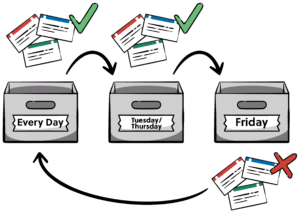Mel sat at her desk, surrounded by mountains of flashcards. Each card posed a challenge.
Do you know this? How well do you know this? What are you missing?
Together, they all posed the same question.
Are you ready for your test?
Mel didn’t know the answer yet, so she got to work.
Mel began by dividing her cards into three distinct boxes, labeled as the Every Day Box, the Tuesday/Thursday Box, and the Friday Box.
Initially, all the cards resided in the Everyday Box. It was the starting line, the place where every piece of information had an equal chance to prove its stickiness in her memory.
Each day, with a steaming cup of coffee at her side, Mel dove into the Every Day Box. She’d quiz herself, flipping each card with a mix of anticipation and dread.
Correct answers earned a card the privilege of moving to the Tuesday/Thursday Box. Incorrect ones, however, were doomed to remain, to be faced again the next day.
The Tuesday/Thursday Box cards enjoyed a less rigorous schedule, only facing Mel’s scrutiny twice a week. Here, the stakes were higher.
A correct answer meant a promotion to the elite Friday Box. A mistake, however, resulted in a demotion back to the daily grind of the Every Day Box.

As the test day approached, Mel looked at her boxes. The Every Day Box was sparse, the Tuesday/Thursday Box modest, but the Friday Box was overflowing. She had mastered the bulk of her material.
And so, with her boxes as her guide, Mel walked into her test, not just prepared but confident. She had conquered her mountain of flashcards, and now, it was time to conquer her test.
What is the Leitner Method?
Mel utilized the Leitner Method, which is a systematic flashcard technique invented by a German scientist named Sebastian Leitner in the 1970s.
Instead of mindlessly reviewing flashcards, this method leverages the power of spaced repetition.
How the Leitner System Works:
- Create Three Different Boxes: Start by creating three different boxes. You can use sticky notes, parts of your desk, or any other way of separating flashcards into three unique piles, but here we’ll just call them boxes. Label these as the Every Day Box, the Tuesday/Thursday box, and the Friday box. The initial phase has all cards in the Every Day Box.
- Start with the Every Day Box: Quiz yourself using the flashcards in this box. If you answer correctly, the card moves to the Tuesday/Thursday box. If you falter, add the card back to the Every Day Box.
- Repeat the Process: Cards in the Tuesday/Thursday box are reviewed less often than those in the Every Day Box. If you nail the answer, move the card to the Friday box. Stumble? It goes back to the Every Day Box. The pattern continues, with cards in subsequent boxes reviewed even less frequently.
- Slowly Move Cards to the Friday Box: Over time, cards that you consistently remember find their way to the last box. Those you struggle with loop back to earlier boxes for more frequent review. The aim is to have all cards in the final box, signaling mastery of the content.
- Create a Fourth Box: If your test is far away, you can create a fourth box that you review every month. This makes sure you still touch on concepts you’ve mastered every once in a while but allows you to further optimize your study time.

Why Does the Leitner Method Work So Well?
Spaced Repetition: The core of the Leitner system is its reliance on spaced repetition. As you encounter information at gradually increasing intervals, it becomes more deeply embedded in long-term memory.
Active Recall: Each time you actively recall a piece of information, such as when you answer a flashcard question, you strengthen your memory and understanding of that information.
Adaptive Learning: The system adapts to your personal learning pace and knowledge level. Cards that you find more difficult are reviewed more frequently, ensuring that more time is spent reinforcing weaker areas.
This personalized approach helps you make studying more efficient. There’s no need for you to review a flashcard every day if you know the concept by heart.
Motivation and Engagement: The physical act of moving cards between boxes can be satisfying and motivating. It provides a visual and tangible way to track progress, so you know that your studying is starting to pay off.
Good luck, and happy studying!
— Alex

